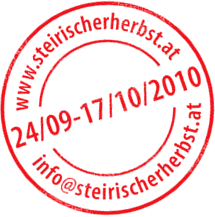 | Ângela Ferreira (MOC, P)
Cape Sonnets
| |

Cape Sonnets, 2010
Sound sculpture
Construction made from raw round timber, loudspeakers, sound system
Broadcast of one of six poems of Peter Blum’s “Cape Sonnets”
Volksgarten, daily every full hour from 10 am - 6 pm.
A pieced-together tower is erected at the edge of Volksgarten. Daily every full hour megaphones attached to the top broadcast short poems in different languages. Angela Ferreira came across this kind of tower in rural areas of Mozambique (her native country), where for along time they were used for collective radio reception in villages and thus appeared as monuments of a specific sense of community. Ferreira combines this kind of connection to information channels with her interest in the different forms of temporary propaganda architecture used for by modernist constructivist artists for their agitprop activities. The contradictory nature of the various utopian ideas in circulation opens up a political terrain of geographies of inequality since established by modernism. Ferreira explores this inequality at the heart of conflicts between “the West” and “the Global South” for Graz by using poems by Peter Blum (1925–1990), who moved from Trieste to South Africa in the 1930s. There in the 1950s he published his “Cape Sonnets,” written in an idiomatic street type of Afrikaans mostly spoken by the so-called “Cape Coloureds,” an early example of politically provocative (and perhaps anti-Apartheid) lyric poetry, which led him to leave South Africa in 1960 after being refused citizenship. Readings of these sonnets are now to be heard in Graz in Afrikaans, English and German from the megaphones at the top of the makeshift tower. Ferreira is interested on the one hand in a situation analogous to the one in Mozambique: people gathering around the tower to listen to the “news” being broadcast, talking about it, interpreting it or making use of it for their own everyday lives. On the other hand, however, this “news” involves the listeners in political circumstances: The return of the sonnets to Europe, and the political history of Blum’s life cause the gathering to appear not as harmless entertainment, but rather make it a starting-point for a mingling of local and global political disputes and for questions as to their links.

Commissioned by steirischer herbst
In co-operation with the Center for Social Research at the Karl-Franzens University Graz & Institute for Contemporary Art (IZK) of Graz University of Technology
With thanks to Hans Kupelwieser
Project supporter Land Steiermark
Project sponsor Think!, Gebrüder Weiss & Alpenländische Schilderfabrik
 |
 24/09 - 02/11
24/09 - 02/11
Utopia and Monument II
Fri 24/09, 5 pm
Vernissage at the exhibition pavilion, Tummelplatz
6 pm
Performance
Paulina Olowska
Onethousandsixhundredand-
seventeen Neons in Warszawa
Andreas-Hofer-Platz
(Roof of carpark)
Interventions of the Institute for Contemporary Art
at the exhibition pavilion
Thu 30/09, 4 - 7 pm
Performative Input
Thu 07/10, 4 - 7 pm
Installation
Thu 14/10, 4 - 7 pm
Sound & media installation
Admission free
Ângela Ferreira
Born in Maputo (MOC) in 1958; lives in Lisbon (P).
 24/09 - 02/11
24/09 - 02/11
Utopia and Monument II
Fri 24/09, 5 pm
Vernissage at the exhibition pavilion, Tummelplatz
6 pm
Performance
Paulina Olowska
Onethousandsixhundredand-
seventeen Neons in Warszawa
Andreas-Hofer-Platz
(Roof of carpark)
Interventions of the Institute for Contemporary Art
at the exhibition pavilion
Thu 30/09, 4 - 7 pm
Performative Input
Thu 07/10, 4 - 7 pm
Installation
Thu 14/10, 4 - 7 pm
Sound & media installation
Admission free
Ângela Ferreira
Born in Maputo (MOC) in 1958; lives in Lisbon (P).


